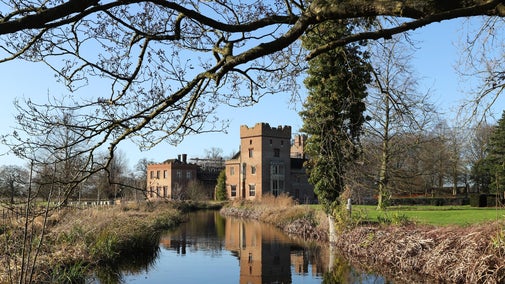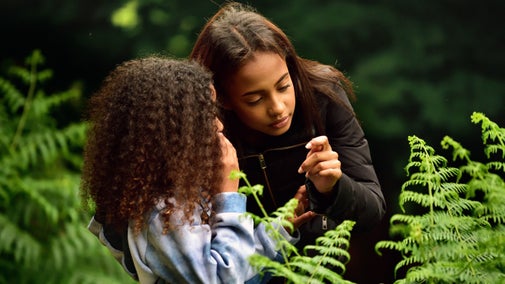
Donate
Everyone needs nature, now more than ever. Donate today and you could help people and nature to thrive at the places we care for.

Our staff and volunteers carry out work throughout the year to conserve Wicken Fen National Nature Reserve for visitors, plants and animals. Discover some of the tasks on our list, from the annual cut to managing the animals helping us with conservation grazing.
Six taps have been turned on across Wicken Fen, to help create a winter wetland for wildlife and reduce CO2 emissions. As gravity enables water to flow from the higher lodes across the fens, more wildfowl are returning to make this national nature reserve their home for the winter.
As the nature reserve expands under the Wicken Fen Vision, it would not be possible to manage the enlarged reserve using traditional methods of human and machinery. Instead, we’ve adopted a more sustainable ‘restoration approach’, based on three key elements:
The natural regeneration of plants
Reducing water loss through field drains and ditches
The use of grazing animals
Grazing animals are essential in developing vegetation in new areas of the nature reserve. The animals help to keep the landscape open and help wetland and grassland plants to become established.
The Konik pony is a very hardy breed originating from Eastern Europe, ideally suited to the type of lowland landscape at Wicken Fen. The Highland cattle originate from the Highlands and Islands of Scotland. They are tough and robust with a placid nature.
We chose these breeds to graze the land at Wicken Fen because they are more than capable of withstanding the rigours of life on the fen throughout the year and thrive on the available vegetation.
The effects the animals have on developing vegetation will vary according to their density and feeding behaviour. Some areas will be grazed heavily, while other areas will be grazed more lightly, allowing the vegetation to grow taller.
The animals also create other habitats such as well-trodden paths through areas of long grass, dusty hollows where they roll, water-filled hoof prints and piles of dung. The animals act as catalysts to help attract new species of flora and fauna to the fen.
Horses tend to snip off selected plants with their incisors, creating a mosaic of cropped lawns. Cattle graze largely by pulling or tearing at vegetation, leaving a landscape with a more tussocky appearance.
With these different grazing characteristics, the breeds are the perfect engineers for the long-term management of vegetation across new areas of the nature reserve.

The East Anglian fens once covered an area over 3,800km2 of deep peat, before being widely drained for agriculture in the 17th century. Here at Wicken Fen, we have one of the last remaining fragments of undrained fenland, and as such, is a unique haven and one of the very last refuges for a host of fenland species dependent on the peatland soils.
The peatland soils at Wicken Fen have a significant role to play in both understanding our past and preserving our future. The undrained area of Wicken Fen (the SSSI, SAC, NNR and Ramsar designated area), contains deep peat depths ranging from 2m-4m. The wider, previously drained areas of the reserve contain peat depths ranging from 5cm-1m. Depending on water table management the peat soils can become either a significant carbon sink (stores carbon), if we can keep the peat wet, or a carbon source (emits carbon) if the peat starts drying out. Once the peat dries out it also starts to shrink, with the drained fens known to be losing 1.5-2cm of peat a year.
At Wicken Fen we are trying to protect the peatland soils for the scarce fenland habitat it supports but also for the role peat plays in our battle against climate change. We are doing this by rewetting previously drained areas and managing the water storage and hydrology of the site to try and maintain a high-water table where feasible in a wider drained landscape. We are currently aiming to restore approximately 225 hectares of peatland, made possible thanks to a Nature for Climate Peatland Restoration grant from Natural England, Starling Bank partnership funding and other donations. Work will be delivered in collaboration with other organisations restoring peatland sites in low-lying areas of Lincolnshire, Cambridgeshire, Norfolk and Suffolk through the Fens East Peat Partnership.
Wicken Fen’s undrained peat soils can also yield lots of information about our past. With a local archaeological consultancy, we are commissioning a research strategy to zone Wicken Fen according to its archaeological potential. This will help inform us of not only past conditions and history but also inform and plan future peatland restoration work, and help us prioritise any archaeological monitoring and excavation, as we face longer, drier summers.

The National Trust plans to improve the condition of all the Sites of Special Scientific Interest (SSSIs) in our care. At Wicken Fen we have a fen harvester to help us do this.
Wicken Fen is a unique remnant of undrained fen, which once covered the vast lowlands of East Anglia. It's not surprising that this unique environment holds a range of designations, including:
Site of Special Scientific Interest (SSSI)
National Nature Reserve (NNR)
Special Area of Conservation (SAC)
Ramsar (an internationally important wetland under the Ramsar Convention)
The SSSI covers an area of 169 hectares and has to be managed carefully to conserve the delicate peat soil and plant communities. Under our management plan, we aim to cut around 40–50 hectares per year. The plant communities at Wicken Fen require regular cutting (every three years) to enable them to thrive.
For centuries the vegetation was cut and cleared by hand. More recently tractors, turners and bailers would do the work. The wetland environment has always made the cutting difficult and some years it’s been impossible for us to complete.
Investing in a specialised fen harvester machine has meant that we can do the job more efficiently. Because it takes less time, it also uses less fuel.
We begin the main annual cut in August and carry on through September and October. We divide the fen into compartments that we cut on a three-year rotation to help sustain biodiversity. The reed leopard moth, fen violet, marsh carpet moth, great crested newt and spined loach are just a few of the rare and important species that rely on this special habitat.
We’re really pleased with the progress we've made with the cutting regime. We’ve also been able to use this versatile machine to help with scrub clearance.
With your ongoing support, we're able to continue our vital conservation work. Thank you for helping to protect these special places.

Everyone needs nature, now more than ever. Donate today and you could help people and nature to thrive at the places we care for.
Young people and their families are invited to pick up their pens and write a Letter to Tomorrow in support of climate action this Great Big Green Week, from 10 to 18 June, at Wicken Fen. This is the first major collaboration between the National Trust and Save the Children UK.

We’ve cared for Wicken Fen National Nature Reserve for over 125 years. Discover its history and how we continue to look after this very special place.

Wicken Fen was the first nature reserve to be managed by the National Trust. Today it’s one of Europe's most important wetlands and home to over 9,000 species.

Learn how we’re planning to care for Wicken Fen Nature Reserve with an ambitious vision to create and preserve a diverse landscape for people and for the wildlife that lives here.
If outdoor activities and learning about nature sound like a good day out for your family, Wicken Fen is the right place for you. Discover everything you need to plan your family day out, from events and activities for kids to hiring bikes.

We believe that nature, beauty and history are for everyone. That’s why we’re supporting wildlife, protecting historic sites and more. Find out about our work.

Read about our strategy, which focuses on restoring nature, ending unequal access and inspiring more people.
